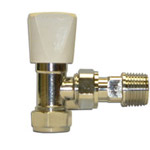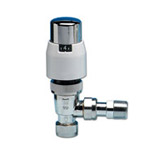Radiator Thermostats & Valves
Introduction
Radiator valves are availabe in two basic forms, Thermostatic or Standard. There is little to choose between the two methods, so personal preference should decide which best suits your heating system and room (or house).
Standard Radiator Valves
Available in pairs, the first is the temperature control valve (automatic or manual) and the second is the lockshield valve, which is used to balance throughput of the hot water to the radiators across the entire central heating system.
Without these valves, radiators placed closest to the boiler would heat up faster than those further away, thereby making one room very hot and the others less cool the further they are away from the boiler.
Lockshield valves are more closed on radiators close to the boiler, and increasingly open as radiators are positioned further from the boiler.

Thermostatic Radiator Valves
These are added to each individual radiator to permit different temperatures around the home. A Thermostatic Radiator Valve (TRV) controls the room temperature by reading the current air temperature and appropriately opening or closing the inlet valve to the radiator to achieve the preset temperature.
This is distinct to a standard valve on a radiator which maintains the temperature of that radiator, regardless of the room temperature.

Valve Connectors
These also come in pairs, labelled as one of the following;
- BBOE – Bottom Bottom Opposite Ends; as with most radiators
- TBOE – Top and Bottom Opposite Ends; old cast iron radiators are often connected like this
- TBSE – Top and Bottom Same Ends; old cast iron radiators are often connected like this
Further information and useful links
- Introduction to radiators
- Hanging radiators
- Bleeding radiators
- Radiator power tables
- decorating radiators
- More Plumbing & Heating topics
- Find a Radiator Supplier near you
- Find a Plumber near you
- Find a Heating Engineer near you
- The Gas Safety Register (gassaferegister.co.uk)
- Gas Regulations (odpm.gov.uk)
Site Pages
Featured Articles





